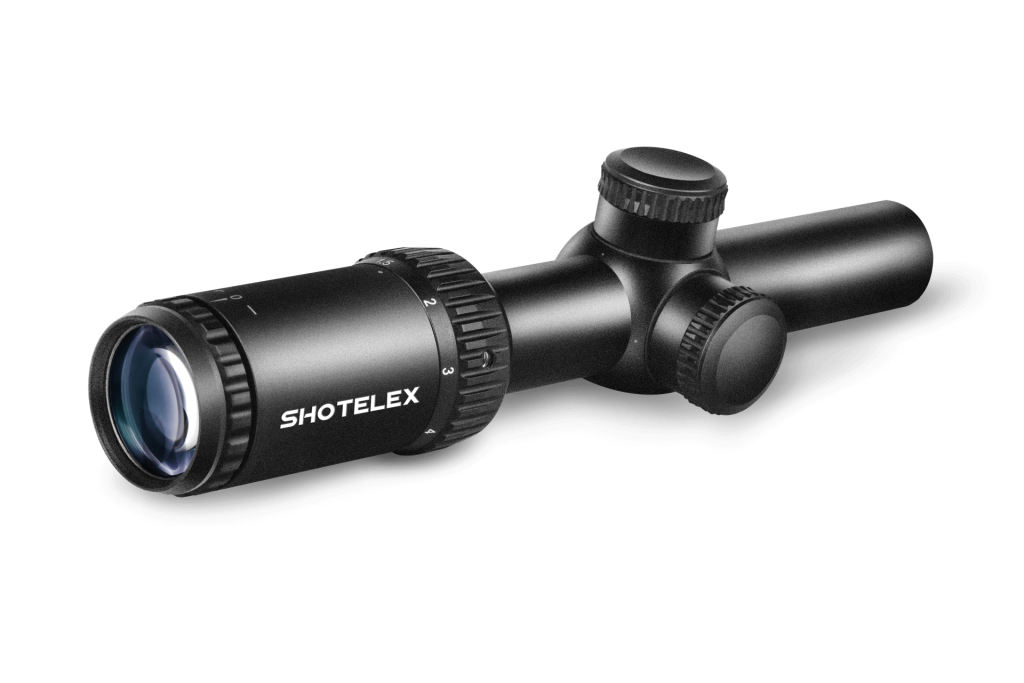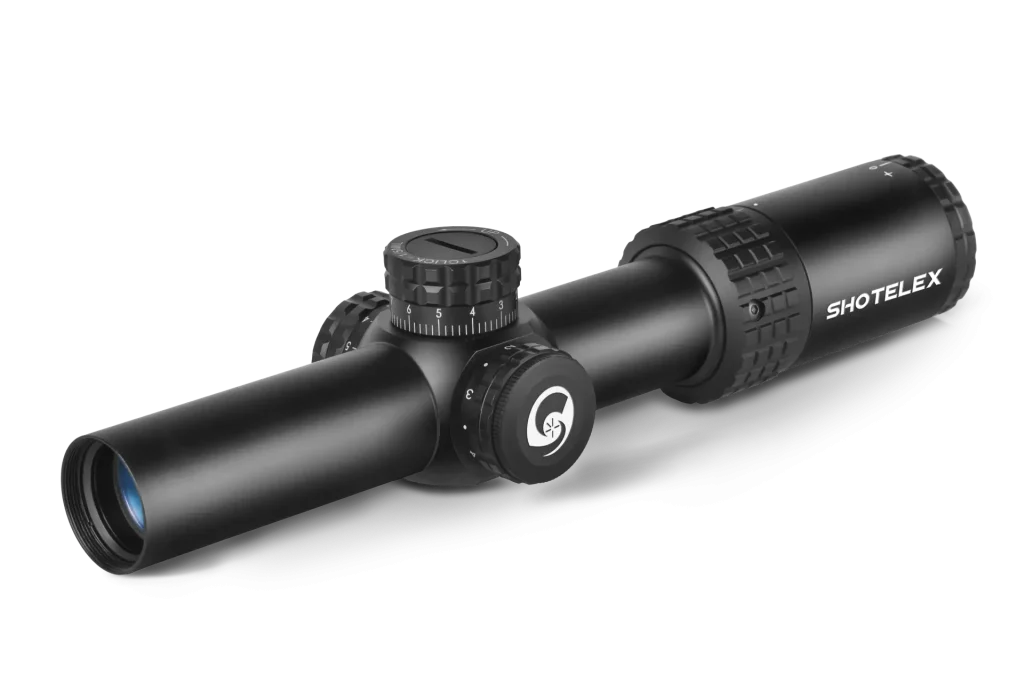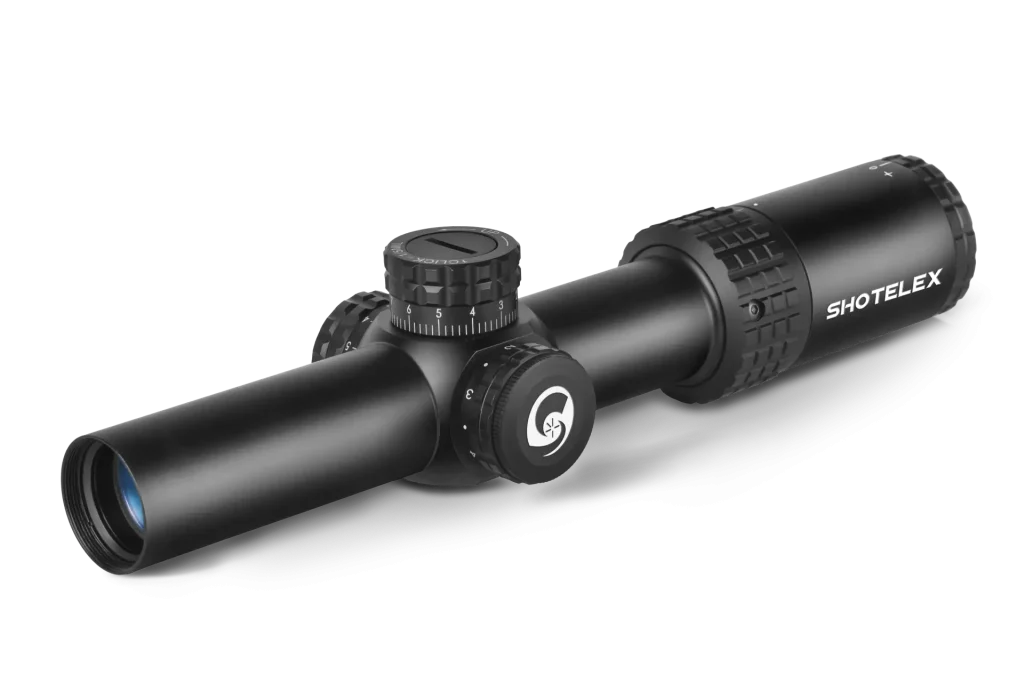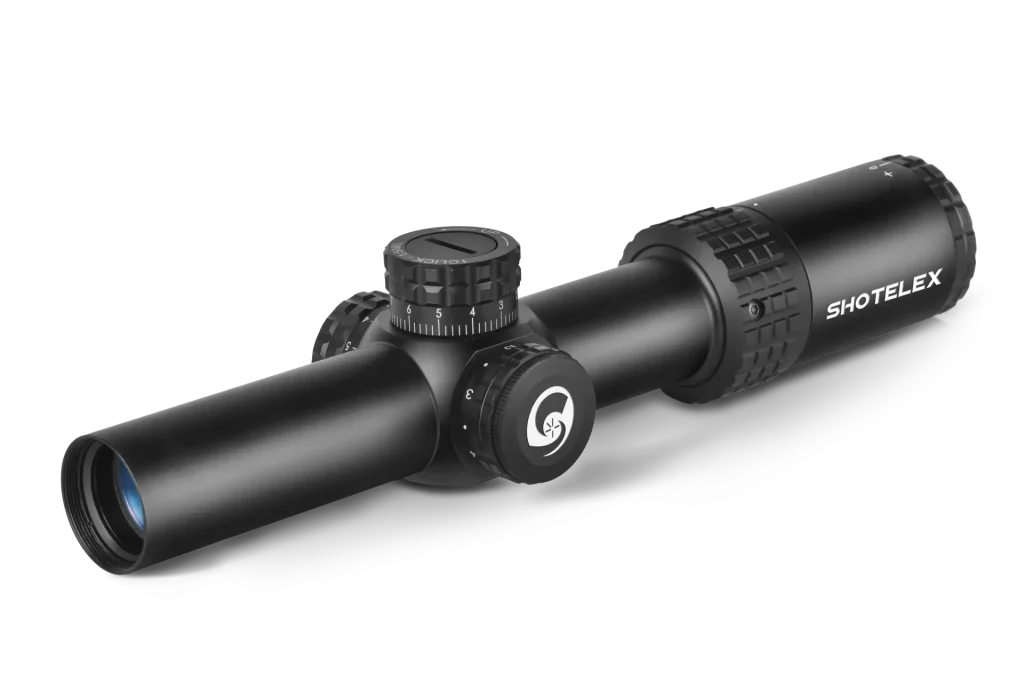What Do the Numbers Mean on a Rifle Scope? – Complete Guide
Many firearm enthusiasts often find themselves puzzled by the numbers marked on rifle scopes when trying to choose the right one. These numbers may seem complex at first glance, but they actually reveal the core performance details of the scope.
Have you ever been unsure of where to begin when faced with these figures? Don’t worry! Here we’ll provide you with a comprehensive guide to understanding what do the numbers mean on rifle scopes.
Part 1. Where to Find the Numbers on Rifle Scopes?
First, let’s make sure you know exactly where to find these important yet seemingly mysterious numbers.
Well, locating these numbers is actually quite simple as they are usually displayed directly in the scope’s model name. For instance, when browsing rifle scope product pages or shopping on platforms, you may come across a product named “Shotelex Hunter Scope Long Range Hunting Scopes Falcon 5-25X56“. The numbers “5-25X56” stand out clearly, and they are precisely what we will focus on decoding.
Now that you know where to find these numbers, let’s delve deeper into their meanings and help you easily unlock the functionality of a rifle scope.

Part 2. What Do the Numbers Mean on Rifle Scopes?
The two sets of numbers on a rifle scope represent its key performance parameters: magnification and the objective lens diameter.
Example: 5-25X56 = 5-25X Magnification and a 56mm Objective Lens
1. Magnification
Magnification is a key parameter of a rifle scope, which measures the magnification of the target when viewed through the scope. It is typically represented as a single number or a range. For instance, “4x” means the target is magnified 4 times, while “5-25x” means the magnification can be adjusted between 5 and 25 times.
This parameter directly affects the clarity of the target you observe and the precision of your shots. The right level of magnification helps shooters aim accurately at different distances and environments.
Examples & Explanation
Fixed Magnification:
For example, “4×32” refers to a scope with a fixed magnification of 4 times and an objective lens diameter of 32mm. Fixed-magnification scopes are simpler in design, often more durable, and generally more affordable.
They are ideal for short-distance shooting or hunting. Since magnification doesn’t change, they are more user-friendly and ideal for shooters who prefer a fixed range for their shots.
Variable Magnification:
For example, “5-25X56” means the magnification can be adjusted between 5 times and 25 times, with an objective lens diameter of 56mm. The advantage of variable magnification is its flexibility, as it allows you to adjust the magnification according to the shooting distance and environment.
Whether it’s close-range rapid targeting or long-range precision shooting, variable magnification can meet a variety of needs.
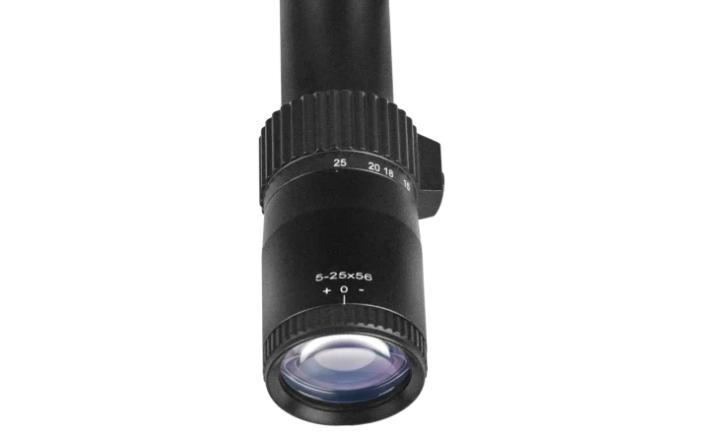
Use Cases
Low Magnification (1-4x):
Low magnification scopes are ideal for quick aiming and close-range shooting. They provide a wider field of view, making it easier to track fast-moving targets. Magnifications from 1x to 4x are suitable for hunting or shooting at shorter ranges, such as in forests or dense areas, where rapid target acquisition is essential.
Medium Magnification (5-9x):
Medium magnification scopes are ideal for shooting at medium distances, making them suitable for most hunting scenarios or outdoor sports. A magnification range from 5x to 9x provides a good balance of clarity and field of view, allowing you to target at moderate distances with precision. These scopes are versatile for different environments, especially in open areas or fields.
High Magnification (10x and above):
High magnification scopes are designed for long-distance shooting, often used in long-range competitions or precision shooting. With magnifications of 10x and above, these scopes allow shooters to clearly see the details of targets at extreme distances.
High magnification is crucial for sniper or competitive shooting, where precise targeting and the ability to identify small details at long ranges are essential. However, the field of view tends to be narrower, so it is best used for long-range shots and target identification.
Scope Magnification Distance Guide Form
| Magnification Range | Recommended Distance | Ideal For | View Magnification |
| 1-4x | Up to 100 meters | Target shooting, small game hunting, property defense | Up to 4 times larger than the target |
| 5-8x | Up to 200 meters | Target shooting, hunting in forests/closed areas | Up to 8 times larger than the target |
| 9-12x | Over 200 meters | Hunting in fields/open areas, long-range shooting | Up to 12 times larger than the target |
| 13-24x | Over 200 meters | Long-range hunting, sport shooting in open spaces | Up to 24 times larger than the target |
2. Objective Lens Diameter
Objective lens diameter refers to the diameter of the lens at the front of the rifle scope, which is typically measured in millimeters (mm). The larger the diameter, the greater the light gathering capability, resulting in a brighter and clearer image. This is crucial for shooters as it affects the performance of the scope under different lighting conditions. A larger objective lens enhances visibility in low-light environments, making it easier to see and identify the target.
Examples & Explanation
For instance, in the scope specification “5-25×56,” the “56” represents the objective lens diameter of 56 millimeters. A larger objective lens helps collect more light, providing a brighter view. In low-light conditions, a larger lens enhances the shooter’s ability to see the target.
However, while larger objective lenses provide improved light-gathering capability, they may also increase the overall weight of the scope. This means you need to find a balance between performance and portability.
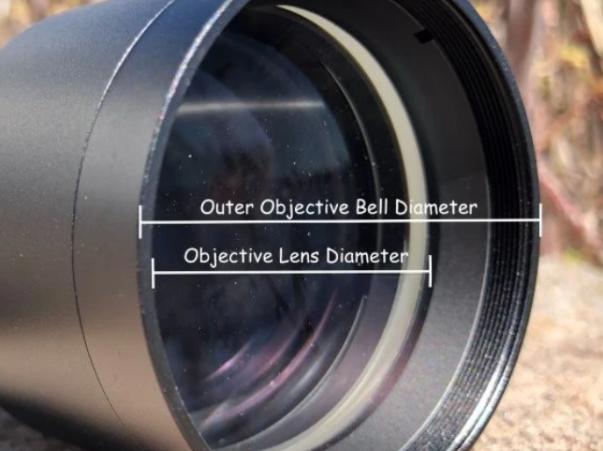
Use Cases
Small Diameter (Below 30mm):
Scopes with smaller objective lenses are typically lighter and more compact, making them ideal for daytime shooting. Since there is abundant light during the day, smaller objective lenses can still provide adequate brightness and clarity.
These scopes are perfect for quick hunting or outdoor activities that require carrying the scope for long periods. They are best used in bright, well-lit environments.
Medium Diameter (40-50mm):
Objective lenses with diameters between 40 and 50 millimeters are the most common. They strike a balance between light-gathering ability and weight, making them suitable for most hunting scenarios.
These scopes offer good performance in a variety of lighting conditions, from daylight to lower-light environments, and are ideal for hunting in open fields or forests where lighting can vary.
Large Diameter (Above 50mm):
Larger objective lenses, typically over 50mm, are designed specifically for low-light or night shooting conditions. They gather more light, making the image brighter in dim or dark environments.
These scopes are ideal for night hunting or shooting competitions where visibility in low light is critical. Although they add extra weight to the rifle, they provide shooters with clearer and brighter images, especially in poor lighting conditions.
Part 3. Other Numbers Should Know When Using Rifle Scopes
In addition to magnification and objective lens diameter, there are other important numbers on the rifle scope that provide valuable performance information for the shooter.
For example, field of view and eye relief are common parameters that directly affect shooting experience and accuracy. Understanding these additional numbers can help you make a more informed choice when selecting the right scope to meet various shooting needs.
Field of View
Field of view refers to the width of the visible area through the scope at a specific distance, typically measured in feet or meters per 100 yards or meters. This helps shooters understand the scope’s coverage, especially in dynamic shooting situations.
- Wide Field of View: Ideal for fast-moving targets like birds or deer, allowing for quick target acquisition and tracking in changing environments.
- Narrow Field of View: Suited for long-range, precision shooting, focusing attention on distant targets while minimizing distractions.
- Choosing the Right Field of View: A wide field of view is best for fast tracking and close-range shooting, while a narrow field of view is better for long-distance precision.

Eye Relief
Eye relief is the optimal distance between the shooter’s eye and the scope’s eyepiece, typically in millimeters. It ensures comfort and protects the eyes from recoil, especially with high-caliber rifles.
- Long Eye Relief (70mm or more): Ideal for high-caliber rifles, preventing injury from recoil.
- Short Eye Relief (40-60mm): Suitable for low-caliber rifles or stationary shooting, offering a more compact design.
- Choosing the Right Eye Relief: Choose eye relief based on the firearm’s caliber and comfort to avoid injury while ensuring a clear view during shooting.
Part 4. How to Choose the Right Rifle Scope Based on the Numbers?
Choosing the Right Magnification
- Low Magnification: Ideal for close-range shooting, providing a wider field of view to quickly aim and track moving targets.
- Medium Magnification: Suitable for mid-range shooting, offering a balance between field of view and magnification, making it versatile for various shooting situations.
- High Magnification: Best for long-range precision shooting, allowing the shooter to clearly see distant target details for accurate aiming.
Choosing the Right Objective Lens Diameter
- Large Objective Lens: Enhances visibility in low-light conditions such as dusk or nighttime shooting by collecting more light.
- Small Objective Lens: Ideal for shooting in bright light during the day, providing a lighter scope for easier handling and extended use.
- Balancing Choice: While a larger objective lens improves light collection, it also increases the size and weight of the scope. It’s important to find a balance that suits your specific needs and shooting environment.
Adjusting Based on Shooting Environment
- In low-light conditions (such as at night or dusk), choosing a larger objective lens and appropriate magnification can significantly improve aiming performance.
- In daylight or well-lit settings, choosing a smaller objective lens and lower magnification helps reduce weight and increase shooting flexibility.

Part 5. Practical Tips for Using the Numbers on Rifle Scopes
Understand Environmental Needs
If you often shoot in low-light conditions, choosing a scope with a larger objective lens diameter can significantly enhance brightness. This is especially crucial in the early morning, dusk, or nighttime as a larger objective lens gathers more surrounding light to provide a clearer view.
Balance Weight and Function
High magnification and large objective lens diameters provide more powerful features but also add extra weight. If you plan to use the scope for extended periods or need to shoot in fast-changing environments, choosing a lighter scope may be more comfortable, especially for long periods of carrying and use. It’s important to balance functionality and portability based on shooting duration and style.
Regularly Adjust Scope Settings
The magnification and focus of a scope are not fixed, and shooters should adjust them based on shooting distance and target type. Adjusting the magnification during shooting helps achieve the best aiming effect and accuracy. For instance, when hunting fast-moving targets, a lower magnification helps capture the target quickly, while for long-range shooting, a higher magnification provides more precise aiming.
Why Investing in a Quality Rifle Scope Matters?
Investing in a high-quality rifle scope is crucial not only for improving shooting accuracy but also for providing consistent visual performance in various shooting environments. Whether in the field for hunting, during shooting competitions, or for self-defense, a top-tier scope helps the shooter make precise decisions at critical moments, ensuring no opportunity is missed due to blurred vision or insufficient light.
Shotelex riflescopes offer superior clarity and durability, making them an excellent choice for any shooter looking to improve their game. Investing in a Shotelex scope significantly increases the chances of success in every shot, providing dependable support when it matters the most.
FAQs
What is the difference between 3×9 and 4×12 rifle scopes?
The 3×9 scope has a magnification range of 3x to 9x, suitable for medium-range shooting, while the 4×12 scope offers 4x to 12x magnification, making it better for long-range precision shooting.
What distance is a 3-9×40 scope good for?
A 3-9×40 scope is ideal for shooting at 50 to 400 yards, with 3x for close-medium range and 9x for medium-long range precision.
How far can you shoot with a 4x12x50 scope?
A 4x12x50 scope is great for long-range shooting, typically effective for distances between 200 to 600 yards, providing precision and brightness in low light.

